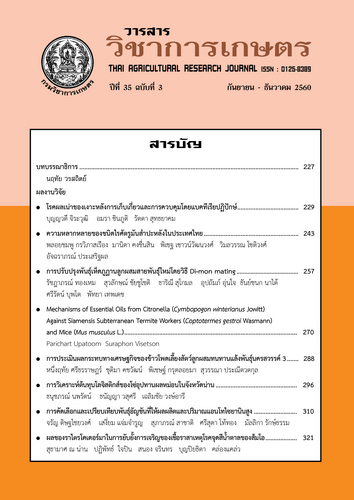การคัดเลือกและเปรียบเทียบพันธุ์อัญชันที่ให้ผลผลิตและปริมาณแอนโทไซยานินสูง
DOI:
https://doi.org/10.14456/thaidoa-agres.2017.15คำสำคัญ:
แอนโทไซยานิน, อัญชันบทคัดย่อ
อัญชันพันธุ์ปลูกทั่วไป มีความแปรปรวนทางพันธุกรรม เนื่องจากในธรรมชาติมีการผสมข้ามโดยแมลง ทำให้ผลผลิต ลักษณะดอก และคุณสมบัติทางเคมีอาจไม่คงที่ ปี พ.ศ. 2554-2556 ได้ทำการคัดเลือกอัญชันพันธุ์ปลูกทั่วไป ที่ศูนย์วิจัยและพัฒนาการเกษตรพิจิตร ใช้วิธีคัดเลือกพันธุ์บริสุทธิ์ เพื่อหาพันธุ์แท้ ให้ผลผลิต จำนวนกลีบดอก และปริมาณแอนโทไซยานินสูง ได้อัญชันพันธุ์แท้ผ่านการคัดเลือก 4 สายพันธุ์ ได้แก่ สายพันธุ์ 7-1-16, 14-2-2, 18-2-5 และ 13 ปี พ.ศ.2557 วางแผนการทดลองแบบสุ่มในบล็อกสมบูรณ์โดยปลูกอัญชันพันธุ์แท้ 4 สายพันธุ์ เปรียบเทียบกับพันธุ์ปลูกทั่วไป พบว่า สายพันธุ์ 7-1-16 ให้ผลผลิตดอกสดสูงสุด 1,639 กก./ไร่ ไม่แตกต่างกันทางสถิติกับสายพันธุ์ 13 และพันธุ์ปลูกทั่วไป ซึ่งให้ผลผลิตดอกสดรองลงมา คือ 1,150 และ 1,144 กก./ไร่ สายพันธุ์ 14-2-2, 13 และ 18-2-5 ให้ปริมาณแอนโทไซยานินรวมสูงสุด 74.7, 74.0 และ 72.5 มล./นน.กลีบดอกสด 100 ก. ตามลำดับซึ่งสูงกว่าพันธุ์ปลูกทั่วไป 12 11 และ 9 % สายพันธุ์ 7-1-16 มีอายุเก็บเกี่ยวผลผลิต 34 วัน แตกต่างกับสายพันธุ์ 13 และพันธุ์ปลูกทั่วไป ซึ่งมีอายุเก็บเกี่ยวหลังปลูก 37 และ 38 วัน สายพันธุ์ 7-1-16 และสายพันธุ์ 13 มีกลีบดอก 5 กลีบ ซ้อนเวียน แตกต่างกับพันธุ์ปลูกทั่วไป ซึ่งมีกลีบดอก 4-5 กลีบซ้อนทับกัน การจำแนกความแตกต่างทางพันธุกรรมในระดับดีเอ็นเอด้วยเทคนิคโมเลกุลเครื่องหมาย พบว่า อัญชันพันธุ์แท้ทั้ง 3 สายพันธุ์ 7-1-16, 14-2-2, 18-2-5 มีความใกล้ชิดทางพันธุกรรม 98-99 %
ดาวน์โหลด
เผยแพร่แล้ว
รูปแบบการอ้างอิง
ฉบับ
ประเภทบทความ
สัญญาอนุญาต
ลิขสิทธิ์ (c) 2018 วารสารวิชาการเกษตร

อนุญาตภายใต้เงื่อนไข Creative Commons Attribution-NonCommercial-NoDerivatives 4.0 International License.
วารสารวิชาการเกษตร



